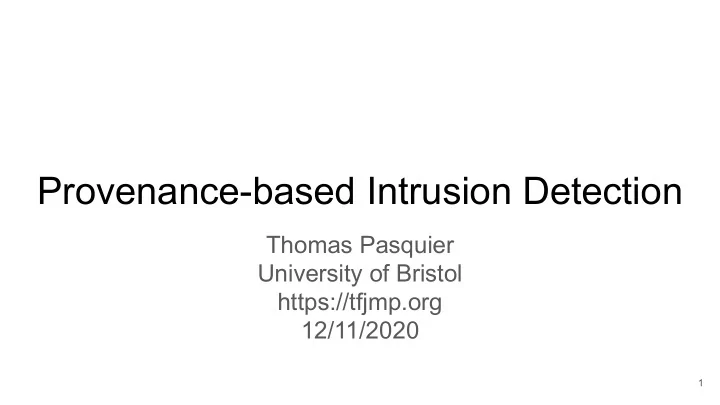

Provenance-based Intrusion Detection Thomas Pasquier University of Bristol https://tfjmp.org 12/11/2020 1
Talk loosely based on following publications ● Han et al. “ SIGL: Securing Software Installations Through Deep Graph Learning” , USENIX Security 2021 ● Han et al. “UNICORN: Revisiting Host-Based Intrusion Detection in the Age of Data Provenance” , NDSS 2020 ● Pasquier et al. “Runtime Analysis of Whole-System Provenance” , ACM CCS 2018 ● Pasquier et al. “Practical Whole-System Provenance Capture” , ACM SoCC 2017 2
Motivation: System call based intrusion detection System Calls 3
Motivation: System call based intrusion detection System Calls Identify abnormal patterns 4
Motivation: System call based intrusion detection System Calls Identify abnormal patterns Hidden among benign actions 5
Motivation: System call based intrusion detection System Calls Identify abnormal patterns Hidden among benign actions Masquerading as benign action 6
Motivation: System call based intrusion detection System Calls [...] Identify abnormal patterns Hidden among benign actions Masquerading as benign action [...] Over a long period of time 7
What is provenance? 8
What is provenance? - From the French “provenir” meaning “coming from” - Formal set of documents describing the origin of an art piece - Sequence of - Formal ownership - Custody - Places of storage - Used for authentication 9
What is data-provenance? - Represent interactions between objects of different types - Data-items ( entities ) - Processing ( activities ) - Individuals and Organisations ( agents ) - Represented as a directed acyclic graph (think information flows) - Edges represent interactions between objects’ states as dependencies - It is a representation of history of a system execution - Immutable (unless it’s 1984) - No dependency to the future 10
How is this useful? 11
Provenance-based intrusion detection ▪ Intuition : provenance graph exposes causality relationships between events 12
Provenance-based intrusion detection ▪ Intuition : provenance graph exposes causality relationships between events 13
Provenance-based intrusion detection Related events are connected even across long period of time ▪ 14
How to perform detection? 15
Assumptions (and limitations) Runtime detection - We target environment with minimal human intervention - - relatively consistent behaviour - e.g. web servers, CI pipelines etc... Build a model of system behaviour (unsupervised training) - - in a controlled environment - from a representative workload (this is hard!) Detect deviation from the model - Several approaches being explored… - 16
Example: UNICORN ▪ Han et al. “UNICORN: Runtime Provenance-Based Detector for Advanced Persistent Threats” , NDSS 2020 17
Example: UNICORN Graph streamed in, converted to histogram, labelled using (modified) 1) struct2vec 18
Example: UNICORN 2) At regular interval, histogram converted to a fixed size vector using similarity preserving graph sketching 19
Example: UNICORN 3) Feature vectors are clustered 20
Example: UNICORN 4) Cluster forms “ meta-state ”, transitions are modelled In deployment, anomaly detected via clustering and “meta-state” model 21
Relatively simple Labelled directed acyclic graph ▪ – node/edge types – security context (when available) Modification and combination of existing algorithms ▪ – struct2vec – similarity preserving hashing – clustering Right combination + domain knowledge ▪ 22
Some insights from this work 23
We can build practical provenance-based IDSs We can detect intrusion out of graph structure with little metadata ▪ – Vertex type (thread, file, socket etc…) – Edge type (read, write, connect etc…) Processing speed ▪ – Current prototype – Data generation speed < processing speed! 24
Proper evaluation is hard! - Dataset are hard to generate - What is a good quality dataset? - Hard to compare across papers, a lot is not available - Experiments (i.e. attacks) - Capture Mechanisms - Analysis pipelines - Leads to unsatisfactory evaluation - I may be able to compare to similar techniques (may reuse dataset) - … very hard for unrelated one (i.e. ingest different data type) - Adversarial ML? 25
Identifying threats: explainability is a problem There is a problem within the last batch of X graph elements ▪ – 2,000 in previous figures Good luck finding out what went wrong ▪ Provenance forensic is an active field of research ▪ – Promising work out of the DARPA programme … but could we do better during detection? ▪ 26
Ongoing projects 27
Towards more interpretable provenance-based IDSs ● PhD student project ( Xueyuan “Michael” Ha n) ● Collaborators ○ Harvard University ○ UBC ○ NEC Labs America ● Deep graph learning techniques ● Precisely identifying attacks within a provenance-graph ● Generating actionable reports 28
A framework for Provenance-based forensics ● PhD student project ( Priyanka Badva ) ● Collaborators ○ SRI International ● Provenance graphs are large and complex (several millions nodes) ● Designing tools and techniques to identify/explain attacks ● Working with my colleague Ryan 29
Distributed IDS - Edge network - Collaboration with Toshiba (£4M) - Exploring distributed learning - Poisoning - Mechanism - Etc. - Large testbed planned (work starting January) - Hiring 2 postdocs at Bristol - Money available for an intern short term (+-covid) 30
Kernel partitioning ● PhD student project ( Soo Yee Lim ) ● Collaborators ○ HP Labs Bristol ○ Royal Holloway, University of London ○ University of Otago ● Leveraging CHERI/ARM Morello hardware ○ Hardware capabilities ● Implement kernel partitioning in the Linux OS 31
Thank you! Questions? https://tfjmp.org thomas.pasquier@bristol.ac.uk 32
How to evaluate? 33
Comparison state of the art Manzoor et al. " Fast memory-efficient anomaly detection in streaming heterogeneous graphs " ACM KDD, 2016. R -> neighborhood size for struct2vec algorithm 34
Evaluation with DARPA datasets 35
Evaluation with DARPA datasets SUCH GOOD RESULTS ARE NOT NORMAL 36
Building our own dataset ▪ Attack designed to look similar to background activity 37
Building our own dataset ▪ Attack designed to look similar to background activity ▪ Is that enough? 38
Runtime performance 39
Runtime performance 40
Runtime performance Memory usage: ~500MB CPU usage 15% on 1 core 41
Recommend
More recommend